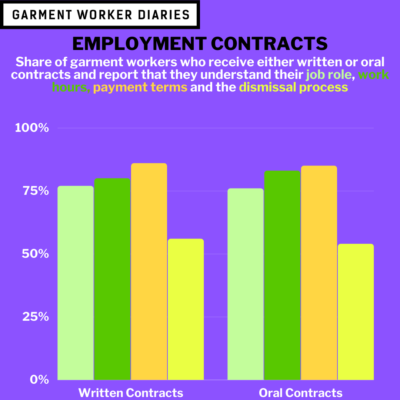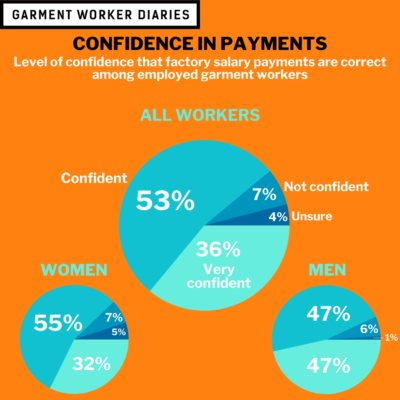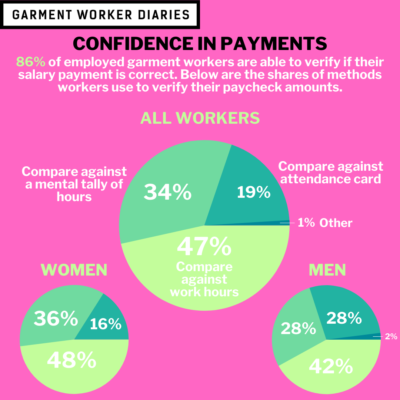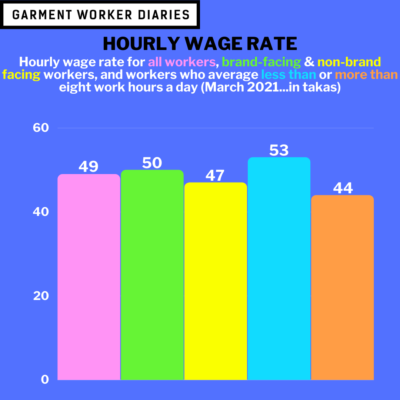Earlier this summer we shared a blog post with you about a workplace contract survey among garment workers in Bangladesh. We first tested the survey among 114 of our worker leaders to ensure that the questions were clear and the format appropriate. We then extended the survey to our full sample of nearly 1,300 respondents and today we’re sharing some of those findings with you.
To summarize, the data suggest that most garment workers believe that they understand the specifics of their work contracts. This pertains to both workers who told us they receive written copies of their contracts, and workers who told us they had their contracts communicated to them orally.
However, we wanted to dig a bit deeper into this reported confidence, and so a few weeks ago we conducted follow-up interviews with a very similar pool of respondents; what we found adds nuance to the findings. Where appropriate, we will interject some of these additional findings to provide extra context to what garment workers have reported to us.
Note: Banner photo courtesy of a garment worker in Bangladesh; numbers in graphs may not sum to 100% due to rounding.
Receiving and Understanding Employment Contracts
As it turns out, garment workers are about as likely to receive a written contract as they are to not receive one, as just under 53% of respondents we surveyed told us they had received a written copy of their contract. Men were just slightly more likely to have received a written contract than women (just over 51% of women received one whereas 57% of men did).
For those workers who were provided their contract in writing, the majority of them report that they understand the particulars of the contract. Specifically:
- 77% of respondents said their contract stated what their job role was and that they understood this role
- 80% of respondents said their contract stated their working hours and that they understood those working hours
- 86% said their contract stated both their payment amount and payment terms, and they understood these items
- 56% said their contract stated possible dismissal reasons and the dismissal process and that they understood these items as well
For workers who weren’t provided a written contract, 81% of them said that the conditions and terms of their employment were communicated to them orally. Likewise, the majority of these respondents understood the specifics of their contract:
- 76% said they understood their job role
- 83% said they understood their work hours
- 85% said they understood their payment amount and payment terms
- 54% said understood the possible reasons for dismissal and the dismissal process
Interestingly, the percentage of workers who said they understood the particulars of their contract was very close for both those who did and did not receive a written contract. This would suggest that the majority of garment workers understand some of the most important terms of their contracts, no matter how the contracts are communicated to them.
Confidence in Salary Payments
When we looked a bit more deeply into payment terms with our follow-up interviews (as mentioned at the top of this blog), we found corroboration in that 76% of respondents told us they were either “very confident” or “confident” that all of the payments from their factory have been correct (only 6% told us they were not confident of accurate payments, and the remainder were either unsure or not working at that time). When we exclude respondents who told us they were presently unemployed, the confidence factor is even higher, with 89% of respondents being either “very confident” or “confident” (with 7% reporting no confidence and 4% uncertain).
Yet, when we asked all working respondents if they receive a written breakdown of their pay (via either a pay slip or an SMS message), over a third, 34%, told us they do not receive such a written acknowledgement. For that third of respondents, a further 39% of them told us that they also do not receive any kind of oral salary breakdown either (which means a full 13% of working respondents do not receive any kind of breakdown of their salary payments, whether written or oral).
Aligning very closely with that 13% who don’t receive a salary breakdown, 86% of respondents told us that they do have some way to verify the accuracy of their paycheck. Most garment workers did not report having found paycheck discrepancies, but 12% told us that they have found paycheck discrepancies within the past 12 months. Among that 12%, 80% disputed the error and for those who challenged their incorrect pay, 54% said they eventually got the payment corrected but 44% said the error in pay was not rectified (2% reported some other resolution occurred).
What these findings might be suggesting is that, on the whole, garment workers feel that they understand their contracts and that their paychecks are not being mishandled. But one final observation we made adds a bit of incongruity to the discussion. We analyzed work hours and wage payments for all workers in our study for January, February, and March 2021. What we found is that when we compared workers who, on average, work eight hours or less per day (all work hours are net of a break time of one hour) with workers who, on average, work eight hours or more per day, those workers who work eight hours or less earn a higher hourly wage rate than their peers who work more hours. In Bangladesh, as in many countries, employees who work overtime (working more than eight hours per day counts as overtime in Bangladesh) are entitled to overtime pay rates, which are higher than normal pay rates. If those workers who are working overtime were being paid the correct higher rates of pay for overtime hours, we would expect to find higher hourly wage rates among those workers. The fact that we found lower hourly wage rates suggests that some workers are not being paid a fair overtime wage rate by their factories. So, regardless of whether or not the majority of respondents in our study believe that they understand their work contracts and trust in the accuracy of their salary payments, there is an underlying rebuttal to that which will take more time and analysis to fully understand.
One last finding which might be worth pointing out is that, just as men were slightly more likely to receive a written contract than women, men were also a bit more likely to say they understood the terms of their written contracts than women. This includes men being slightly more likely to say they understand their job role, working hours, payment terms and the dismissal process.
Among those garment workers who received no written contract, the disparity between men and women grows, starting with whether or not the terms of employment were communicated orally: 76% of these women said they received oral communication about their employment terms compared to 95% of men. Men in this category were still a bit more likely than women to say they understood the particulars of their orally communicated contract.
The data presented here come from interviews conducted over the phone in July 2021 with a pool of 1,278 workers and from another set of interviews conducted over the phone in August and September 2021 with a similar pool of 1,276 workers These workers are employed in factories spread across the five main industrial areas of Bangladesh (Chittagong, Dhaka City, Gazipur, Narayanganj, and Savar). Just over three-quarters of the working respondents are women, roughly representative of workers in the sector as a whole.




